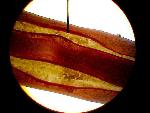
|
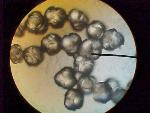
|
 |
|
|
|
|
Scope Stuff
Click images to enlarge
Our friend Rich Sacher, American Aquatic Gardens, New Orleans, paid us a visit in January and sparked a whole new area of interest for us all. Having become very interested in hybridizing tropical waterlilies, Rich utilized our winter blooming varieties to expand his techniques of studying pollen viability.
Rich figured out that he could swirl waterlily anthers in waterlily nectar (from first day sterile flowers) and have a concentration of pollen grains to look at under the microscope. He then "incubated" the mix by taping little cups of it in the top of our covered Victoria seedling aquarium. We were all able to watch the pollen germinate and send out pollen tubes under the microscope!
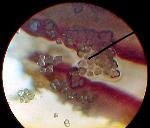 |
||
|
Victoria anther closeup |
Victoria anther & pollen |
Soon after Rich's visit, our amazonica started blooming again and we decided to see if we could do the same thing with Victoria pollen. Could we ever! But what we were seeing was quite different than with waterlily pollen! We did a crude drawing which we sent to Rich, Nancy Styler and Stan Skinger. Stan offhandedly suggested that, if we had a camera mount on the scope, we should take digital pictures instead.
Well, we didn't have a camera mount but why not try it anyway? By slowly wiggling the camera lens very close to one of the scope's eyepieces, we could actually snap the image! Viewed on screen, the pictures were phenomenal and could be shared easily by email!

|

|
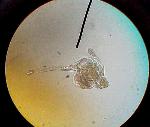
|
 |
|
|
|
Beginning pollen tubes |
|
What we were seeing that was so different was that Victoria pollen appeared to be four cells stuck together rather than the single cell of waterlily pollen. And instead of the single rather straight pollen tube of the waterlily, Victoria pollen grew multiple tubes that corkscrewed. Dr. Ed Schneider generously looked at our images and confirmed the unique "tetrad" nature of Vic pollen and the helical growth of the tubes.
We're not sure this has any real value or application but it certainly is interesting! We thought this "in vitro" method would tell us something about pollen viability in actual flowers. Results both ways after storage of pollen were pretty consistent but were misleading when looking at the pollen of early cruziana flowers. In those cases, pollen that did germinate artificially still did not produce seeds in flowers.
We became interested in looking at many parts of Victoria under the microscope. Below are ovules prior to fertilization and an ovule showing the micropyle, the place the pollen tube enters to fertilize the ovule, just below the pointer tip.
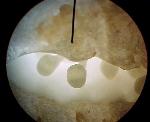 |
 |
|
|
|
Enchanted Forest | Can It Happen? | Open The Door!
1999 The Adventure Continues | 2000 A Very Bad Year | 2001 A Banner Year
2002 An Even Better Year | 2003 We Like It Like This | 2004 Trust
2005 Recovery | 2006 Normal? | 2007 Weird | 2008 Year of the Hare
2009 Year of the (White) Tortoise
